Works on low temperature physics at the Institute of Physical High-Technology (IPHT Jena) have already been presented in the volume of the Jenaer Jahrbuch, the yearbook of 2004.
53 The department of "cryoelectronics" was the only one that established a field of activity during the foundation of the institute which had not had its own tradition in the prior institutes of the academy. Such a beginning offered unique opportunities at the turn of events after reunification. Global engagements in the field of research of the new high temperature superconductors, which were also realized by the corresponding support program in Germany, a generous promotion of the new eastern states of Germany by the government as well as the strong and financial engagement of the state of Thuringia helped create good financial preconditions for the installation of a new technologically sophisticated field of research at the IPHT. The inclusion of new experts in the field of superconducting electronics, such as Eckhardt Hoenig from Siemens Erlangen who became new head of the research field, and previous employees from FSU, such as Hans-Georg Meyer, Hans-Joachim Köhler as well as some students and graduates) substantially and immediately helped to keep up-to-date with the knowledge of superconducting devices. Due to Hans-Georg Meyer´s foresight, who was new head of the department, not only a fabrication line of devices made of the newly discovered oxidic high temperature superconductors from 1986 (YBCO, working temperature of 77 K) was built, but also a fabrication line of the traditional metallic low temperature superconductor of niobium which works at a temperature of 4,2 K.
These lines of technology were installed in the newly built cleanroom of the IPHT which superseded the cleanroom technology previously used by the AdW and FSU on the Beutenberg, but first they continued to use the e-lithography systems by Zeiss. They comprise the deposition of superconducting, metallic and insulating films necessary for superconducting devices and their structuring with chemical and physical methods as well as the lateral structure fabrication by means of optical and electron beam lithography. As a result, it is possible to produce superconducting electronic devices, the complexity of which is comparable to that of modern semiconductor circuits. To give an example, the Josephson voltage standard circuits consist of 19.700 integrated Josephson junctions, and malfunctions may not occur in any of them.
54 Hans-Joachim Köhler´s, Gerd Wende´s and Marco Schubert´s knowledge of the interaction between Josephson devices and microwaves as well as the technological implementation by the group of Ludwig Fritzsch are reflected in this context.
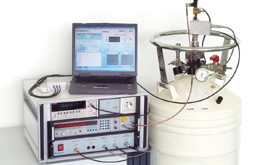 figure 21: Josephson voltage standard system for 10 volts
figure 21: Josephson voltage standard system for 10 volts
In figure 21, a fully automated Josephson voltage standard system is shown, which results from project work in close co-operations with the PTB Braunschweig. In the meantime many important national institutes use the voltage standards developed by IPHT. The significance of the voltage standard results from the international agreement on the use of a much higher precision of measurements of frequencies instead of the earlier ampere definition.
The fabrication of complex cryoelectronic circuits on an quasi-industrial level has also been reflected in the fact that the "producing" part of the department has become the niobium foundry and the manufacturer of superconducting computing circuits in Europe. The reliability on works of the department has been proven by the ISO 9001 certification of the whole process sequence.
The department has constantly grown since its foundation. It comprises approx. 40 scientists and technicians as seen from the year 2006. Four years earlier, the department was renamed as "quantum electronics" that referred to the flux quanta as the carriers of used effects whereas the previous name giver for "cryoelectronics" that referred to the cold represented just one instrument to the creation of the appropriate conditions for superconducting electronics. The Supracon AG was established in 2001 in order that the increasing demand of partners from industry for the tool development of the IPHT could be met reliably.
All that would not have been possible if the developments had solely focused on the superconducting device in the department of quantum electronics at the IPHT. The continuous adherence to the systems, the center of which is naturally the superconducting device around which they consist of additional components necessary for using them in the application, has essentially contributed to sustained success. The Josephson voltage standard and the SQUID systems are two traditional fields of the development, the latter of which has developed into the most important foundation of the department in the following years. Since SQUID systems have been field-tested and permanently used in practice, the reconciliation of two completely different things has been successful over the years, that is to say the extremely high sensitivity of the SQUID sensors in comparison with the smallest measuring magnetic fields, on the one hand, and the simultaneous disturbance robustness that is important to most of the applications, on the other hand. This has paved the way for drawing the attention of industry to an increased direct financing of developments which prevented the IPHT and the developments involved from going broke, as the promotion program of superconductivity ran out.
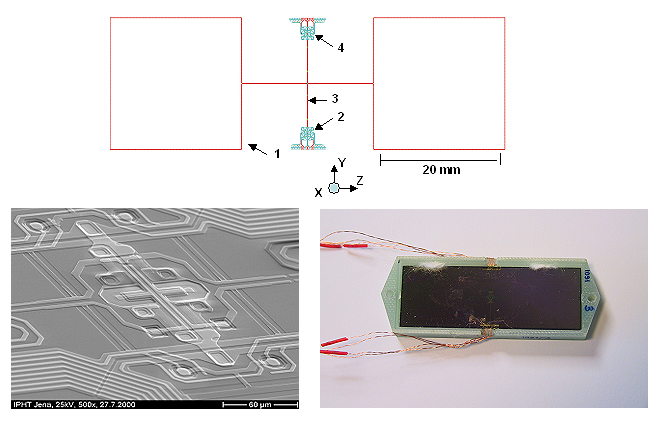 figure 22: (top): scheme of arrangement (1 = antenna, 2 = reference SQUID magnetometer, 3 = feeder for antenna with crossing, 4 = SQUID for coupling the gradiometer antenna); (bottom left): SEM picture of the central part of a SQUID; (bottom right): pict
figure 22: (top): scheme of arrangement (1 = antenna, 2 = reference SQUID magnetometer, 3 = feeder for antenna with crossing, 4 = SQUID for coupling the gradiometer antenna); (bottom left): SEM picture of the central part of a SQUID; (bottom right): pict
The development of an extremely sensitive and highly balanced SQUID gradiometer which was tested by Ronny Stolz in co-operation with Viatcheslav Zakosarenko at a temperature of 4 K can be seen as a cornerstone on this way(figure 22).
55 A very high sensitivity of gradients simultaneous with a strong suppression of all the homogeneous magnetic fields can be achieved by its complex structure. This highly balanced gradiometer makes up the core of a series of application-oriented developments. Many of the system components around it, such as adapted SQUID electronics, cryostat or measuring head, are specific to the respective application of the SQUID measuring system. In this context, Marco Schulz´s developments of electronics are not unimportant.
The mapping of the terrestrial magnetic field gradient from the air is the most challenging field test. It is aimed at detecting materials with different magnetic properties which allow for location of natural resources under the Earth´s surface. For the exact localization and even for the determination of the depth, the SQUID system is equipped with five highly sensitive SQUID gradiometers and three magnetometers. This helps to measure the complete magnetic field gradient tensor of the earth from airplanes or helicopters.
56 This is the first system worldwide to allow for such aerial measurements.
There is a variant of it that consists of just one gradiometer for one measuring channel which is used for the mapping of the magnetic field on the ground. At this point, it is to be explained in detail as an example of all the many sophisticated SQUID measuring systems.
Magnetic prospection in archeology is aimed at detecting traces of human activities by means of high measuring performance without excavation. Bricks or ceramics can be detected by slight disturbances of the terrestrial magnetic field in this way. Rotten wood also leaves such a trace because bacteria that decompose the wood are slightly magnetic. Archeologic mapping of human activities in the past is obtainable when it is possible to filter out these little signals from the larger background of the terrestrial magnetic field and exactly allocate them to the measuring site.
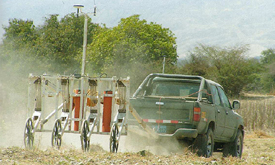 figure 23: SQUID system for archaeological prospection, here shown in Peru. The measuring carriage is pulling by a SUV.
figure 23: SQUID system for archaeological prospection, here shown in Peru. The measuring carriage is pulling by a SUV.
The whole system that is field-tested is shown in figure 23. The vehicle that carries all the measuring instruments is completely built without any use of metal in order to avoid disturbances of subtle measurements, and it has four independently suspended wheels which also make off-road field-tests possible. The SQUIDs are inserted into two cryostats for fluid helium (which can be identified with its orange-colored protective shells in figure 23) which ensures a temperature of 4 K in field-tests. Two antennas are fixed on top of one pole which are the GPS antenna (GPS stands for global positioning system.) for localizing the measuring site and the radio antenna which measures the signals of one externally positioned GPS reference antenna. Taken together, the precision of the localization can be achieved in the range of centimeters. With the help of the inertial unit on the vehicle, the position of the SQUID sensors across the measuring field, which is actually of interest, is calculated from the position of the GPS antenna. As movement goes on, the operator has control of all the collected data in the jeep, including the position, because of real-time indications on the display of a notebook.
The measuring system of the IPHT Jena is unique throughout the world, because its parameters enable resolution of local changes of the magnetic field up to one one-billionth part of the terrestrial magnetic field and the corresponding allocation of the site up to the range of centimeters.
57 In addition to this, the SQUIDs used also allow for measurements that are much quicker than other high-precision magnetic field sensors. This is why an off-road vehicle is used to cross the measuring field speedily, by which progress is made in measuring of approx. one hectare per hour. For the first time, it is therefore possible to characterize large areas completely magnetically in periods of time that are economically justifiable. Andreas Chwala, Volkmar Schultze and Sven Linzen tested and improved the system in many applications.
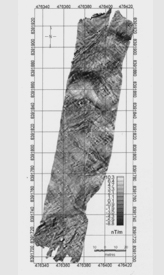 figure 24: magnetic field gradient of a measuring area (Palpa/Peru), recorded with the measuring system see figure 23
figure 24: magnetic field gradient of a measuring area (Palpa/Peru), recorded with the measuring system see figure 23
One example of the result of such a magnetic prospection is given in figure 24. It shows the magnetic field gradient across the georeferenced coordinates of a measuring field near Palpa/Nasca in Peru which is about the size of 240 x 40 m
2 and covers an area that is known by its large, more than 1000-year-old geoglyphs in the desert. At the top of the magnetogram, many geometric components that point to early settlement structures along with a modern oblique path can be seen.
The final example of the many-faceted opportunities of application of the highly balanced SQUID gradiometer is given in figure 25, in which the recording of a fetal magnetocardiogram is shown.
58 In contrast to available systems, this innovation opens up the possibility to be independent of intricate and expensive magnetic shielding cabins and thus to be able to record the heartbeat of the unborn child in every doctor's office.
A whole group that aimed at a brand-new field of research was formed in co-operation with FSU within the department in the last few years. It deals with the realization of quantum bits and quantum computers by the help of superconducting circuits.
59 In this context, it was possible for the first time to couple three or four qubits with one another, which is considered an important step on the way to real quantum computers. The superconducting structure that is especially used for this purpose is illustrated in figure 26. The efforts and activities of the group of Evgeni Il’ichev were honored with the Thuringian award for achievements in research in 2004.
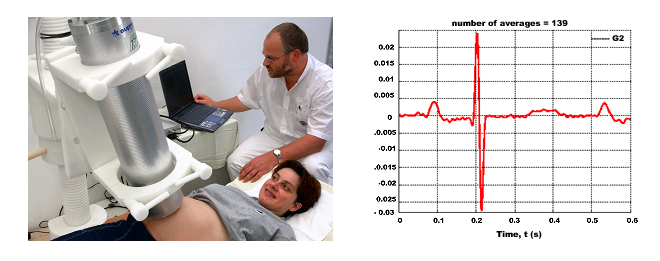 figure 25: SQUID system from the IPHT in use; (left): unshielded recording of a fetal magnetocardiogram; (right): fetal MCG
figure 25: SQUID system from the IPHT in use; (left): unshielded recording of a fetal magnetocardiogram; (right): fetal MCG
The department of quantum electronics of the IPHT has become a partner in the development and application of devices and systems in the field of flux quantum sensors and flux quantum electronics with worldwide respect and in great demand after more than a decade of permanent development of expertise and technologic infrastructure. A series of innovations in the field of basic research as well as the field of applied research that have been much noticed all over the world have originated from this department. All the work groups have reached an advanced international level in their respective field of activity, or they themselves define this level, such as in the field of high-resolution geophysical exploration or the development of solid state qubits for quantum computer science.
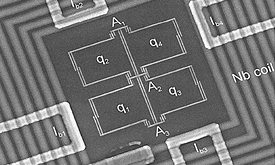 figure 26: SEM micrograph of a 4 qubit chip
figure 26: SEM micrograph of a 4 qubit chip
Reports on HTS results of the department of magnetoelectronics, especially in view of bolometer, superconducting filter and the growing of new thin-film materials, as well as on the department of magnetics in view of one-crystal growing as well as on "heavy applications" of HTS for energy storage units, electric motors and levitation were already published in the yearbook in 2004.
53
The technologic infrastructure for the development and application of detectors and devices, which has been created at the IPHT, is unique at the national and international levels and ranges from its simulation and a computer based draft over fabrication in the scope of multilayered thin-film systems and their microstructuring and nanostructuring and over the corresponding packaging to the characterization and application in specially developed, customer-specific, complex measuring systems.
literature
53. H. Barthelt / Dintner, H. / Fischer, K. / Hoenig, E. / Stafast, H.: Institut für Physikalische Hochtechnologie - Forschung und Technologie für innovative Systeme. In: Jenaer Jahrbuch für Technikgeschichte Bd. 6, Jena: Glaux Verlag, 2004
54. May, T. / Schubert, M. / Wende, G. / Hübner, U. / Fritzsch, L. / Meyer, H.-G.: Cross Type Sub-micron Josephson Junctions Using SNS Technologie for Josephson Voltage Standard Applications. In: IEEE Trans. Appl. Supercond. 13 (2) (2003)
55. Stolz, R. / Fritzsch, L. / Meyer, H.-G.: LTS SQUID sensor with a new configuration. In: Supercond. Science & Technol. 12 (11) (1999)
56. Meyer, H.-G. / Stolz, R. / Chwala, A. / Schulz, M.: SQUID technology for geophysical exploration. In: physica status solidi (c) 2 (2005)
57. Schulze, V. / Chwala, A. / Stolz, R. / Schulz, M. / Linzen, S. / Meyer, H.-G. / Schüler, T.: A SQUID system for geomagnetic archaeometry, 6th Int. Conf. on Archaeological Prospection (Archeo 2005), 14-17 Sept. 2005, Rom
58. Stolz, R. / Zakosarenko, V. / Bondarenko, N. / Schulz, M. / Fritzch, L. / Oukhanski, N. / Meyer, H.-G.: Intergrated SQUID-Gradiometer System For Magneto-Cardiography Without Magnetic Shielding. In: IEEE Trans. Appl. Supercond. 13 (2) (2003)
59. Grajcar, M. / Izmalkov, A. / van der Ploeg, A.H.W. / Linzen, S. / Plecenik, T. / Wagner, Th. / Hübner, U. / Il'ichev, E. / Meyer, H.-G. / Smirnov, A. Yu. / Love, P.J. / Maassen von der Brink, A. / Amin, M.H.S. / Zagoskin, A.M.: Four-qubit device with mixed couplings. In: Phys. Rev. Lett. 96 (2006)
« back
Contact us
Supracon AG
An der Lehmgrube 11
07751 Jena
Germany
Tel.: +49-3641-2328100
Fax.: +49-3641-2328109
info(at)supracon.com






